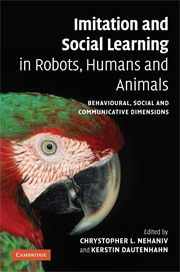 Imitation and Social Learning in Robots, Humans and Animals
Imitation and Social Learning in Robots, Humans and Animals Book contents
- Frontmatter
- Contents
- List of plates
- List of figures
- List of tables
- List of contributors
- Introduction: the constructive interdisciplinary viewpoint for understanding mechanisms and models of imitation and social learning
- Part I Correspondence problems and mechanisms
- Part II Mirroring and ‘mind-reading’
- Part III What to imitate?
- Part IV Development and embodiment
- Part V Synchrony and turn-taking as communicative mechanisms
- 13 How to build an imitator
- 14 Simulated turn-taking and development of styles of motion
- 15 Bullying behaviour, empathy and imitation: an attempted synthesis
- Part VI Why imitate? – Motivations
- Part VII Social feedback
- Part VIII The ecological context
- Index
- Plate section
- References
13 - How to build an imitator
Published online by Cambridge University Press: 10 December 2009
- Frontmatter
- Contents
- List of plates
- List of figures
- List of tables
- List of contributors
- Introduction: the constructive interdisciplinary viewpoint for understanding mechanisms and models of imitation and social learning
- Part I Correspondence problems and mechanisms
- Part II Mirroring and ‘mind-reading’
- Part III What to imitate?
- Part IV Development and embodiment
- Part V Synchrony and turn-taking as communicative mechanisms
- 13 How to build an imitator
- 14 Simulated turn-taking and development of styles of motion
- 15 Bullying behaviour, empathy and imitation: an attempted synthesis
- Part VI Why imitate? – Motivations
- Part VII Social feedback
- Part VIII The ecological context
- Index
- Plate section
- References
Summary
Introduction
The aim of this chapter is to parallel the development of imitation in a human infant and in an autonomous robot. To draw a valid comparison between the two systems – namely the infant and the robot – it is necessary to insure that their respective architectures present sufficient basic similarities. The present chapter will thus start with a description of the main features that enable a human neonate and the autonomous robot designed by the ETIS group to develop a capacity to imitate. Note that the robot is not implemented to imitate and that imitation will develop spontaneously as a result of the capacity of the robot to couple perception and action together with an imprecision in its visual perception.
Within the framework of a bottom-up perspective, we propose in the second part of the chapter to consider the development of imitation as a continuous phenomenon throughout development. Consequently, we will devote the third part of the chapter to show how basic perception–action coupling may not only account for the development of learning but also for the development of the communicative function of imitation. Exploring the communicative function of imitation is a new topic for roboticists, who classically consider imitation as a way to learn more rapidly relevant interactions within a novel environment. A model of synchronization of rhythm between two systems describes the first steps toward a communicative use of imitation.
- Type
- Chapter
- Information
- Imitation and Social Learning in Robots, Humans and AnimalsBehavioural, Social and Communicative Dimensions, pp. 279 - 300Publisher: Cambridge University PressPrint publication year: 2007


